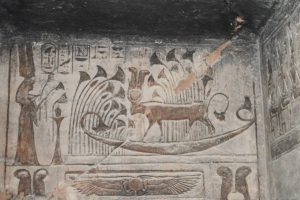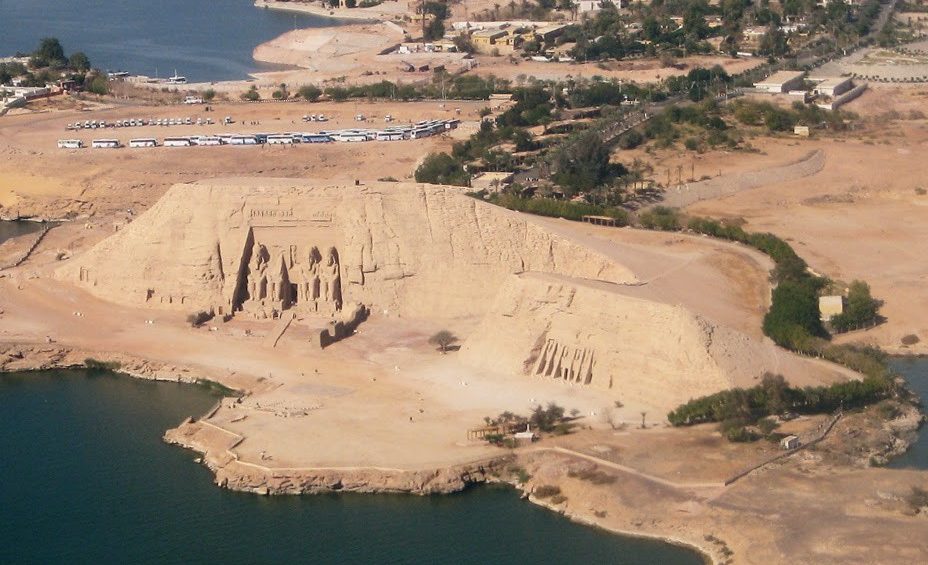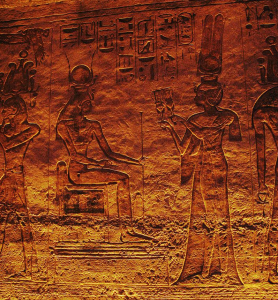An Aerial View of the Abu Simbel Temples
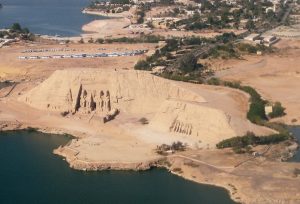
The Small Temple of Abu Simbel
King Ramses II built the small temple for his wife, Queen Nefertari, and the goddess Hathor. The small temple of Queen Nefertari is located one hundred meters north of the great temple, carved into the rock which the ancient Egyptians called the “pure mountain” or the “northern mountain.” Before the construction of Nefertari’s temple, the local people used to come to this mountain because they believed that the spirit of the goddess Hathor dwelled within it. King Ramses II took advantage of the people’s belief in Abu Simbel and carved a temple dedicated to both his wife, Queen Nefertari, and the goddess Hathor. The small temple of Abu Simbel, or the Temple of Hathor in Abu Simbel, located in Aswan, is carved into the rock north of the great temple of Ramses II. In front of it stand six colossal statues, about 10 meters high. Four of these statues are of King Ramses II standing, and there are two statues of his beloved wife, Queen Nefertari, also standing. Surrounding the statues of the king and his wife are smaller figures of princes and princesses of the family of Ramses II. The interior reliefs depict Nefertari in front of the goddesses Hathor and Mut, and depict King Ramses II as victorious. The entrance leads to a hall containing six columns, and in the entrance and adjacent chambers there are colorful scenes of the goddess Hathor and her sacred chariot.
The Small Temple of Abu Simbel
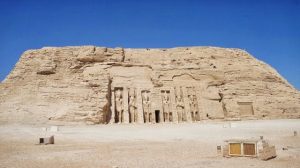
UNESCO Relocated the Temple to its Current Location (from the 1960s to 1980s)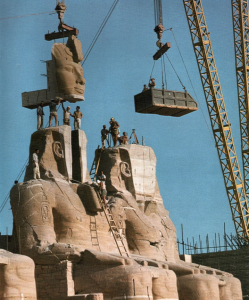
Description of the Temple
he temple consists of a facade with six statues, followed by a hypostyle hall, a transverse hall, and a small sanctuary with two attached chambers on either side.
The Temple Facade
The small temple has a facade with six colossal statues. Four statues are of King Ramses II and two are of Queen Nefertari, each approximately 13 meters tall. At the feet of the king are four princes, and at the feet of the queen are two princesses, all children of King Ramses II and Queen Nefertari. The facade is 28 meters wide and about 13 meters high. On the lintel above the doorway, there are scenes of the king before the goddess Hathor and the queen before the goddess Isis. The statue of Queen Nefertari is located on the northern side, to the right of the entrance. The queen is depicted wearing a beautiful, transparent dress, holding a sistrum, and wearing the distinctive Hathoric crown (consisting of two feathers between a solar disk).
The Temple Façade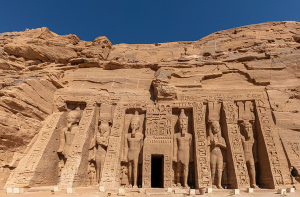
The Hathoric Hypostyle Hall
Despite the fact that most of the temple’s scenes focus on religious rituals such as offering flowers, wine, and burning incense before offerings, the artist highlighted the feminine beauty and delicate lines of the queen and goddesses’ forms. He relied on emphasizing the aesthetic features of women. The hall consists of 6 columns. On each column, the face of the goddess Hathor is depicted as a beautiful woman with cow horns and her temple on her head. On the walls of the columns, the queen is depicted four times and the king twice. On the walls of the hall, there are 18 scenes. Four of these are military scenes of King Ramses II, and the rest are religious scenes of the king and queen with various gods. All the engravings on the columns represent images of musical instruments. One of the most beautiful scenes on the southern wall depicts the goddess Hathor giving King Ramses II a necklace called “Menat” by the ancient Egyptians, a necklace for achieving happiness. Then there is a scene of the king between Horus and Seth, who are placing the double crown on the king’s head, which is called the coronation ceremony. Then there is a scene of the king offering a small statue of the goddess Maat (goddess of truth and justice) to the god Amun-Ra, which means that the king is walking on the path of truth and honesty with the help of the god Amun-Ra.
Important Scenes of the Queen on the Rear Wall
There are many scenes of the queen in front of the goddesses Hathor and Mut, the wife of Amun, offering them sacrifices such as flowers and sistrums. On the north wall, to the right of the entrance, we find the king offering a libation of holy water to the god Ra-Hor Akhty, and the king worshipping the god Ptah, while the queen worships the goddess Hathor.
This scene depicts the gods Seth and Horus crowning King Ramses II with the double crown.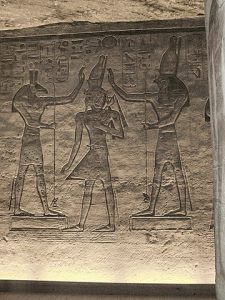
The queen, with the Hathorian crown on her head, presents musical instruments to the goddess Hathor
The Hathoric Hypostyle Hall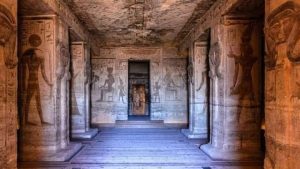
The face of Hathor on the columns, as a beautiful woman with cow’s ears, and on her head is an image of the temple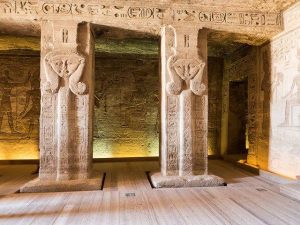
The Transverse Hall
This hall is rich in scenes depicting the king offering wine to the deities Amun-Ra and Ra-Hor Akhty. He also presents offerings to the god Horus. There are two attached chambers. Above the entrance to the southern chamber, we find the king offering incense to the goddess Hathor, who is depicted as a cow wandering in a boat. Then, there is a scene of the king and his wife offering flowers to the goddess of childbirth and protector of children, Taweret, who is depicted in a completely feminine form and wearing the Hathoric crown (although her original form is that of a woman with a crocodile’s head and a hippopotamus tail, symbolizing protection of the child).
Scenes in the Hall Dedicated to Queen Nefertari]
On the eastern wall of the southern side, there are scenes where the queen stands between the goddesses Hathor and Isis and is being crowned with the Hathoric crown (two feathers with a sun disk between them). Above the entrance to the second chamber from the north, we find scenes of the queen offering flowers to the cow Hathor, who is sailing in her boat in the marshes of the delta. And another scene of the queen offering flowers to the triad of Elephantine (Khnum, Satet, and Anuket).
The most important scenes of the temple are Isis and Hathor crowning the queen with the Hathoric crown
The most important scenes of the temple are Isis and Hathor crowning the queen with the Hathoric crown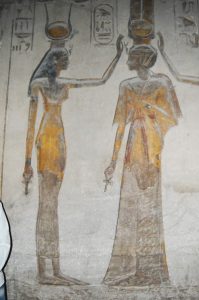
The Transverse Hall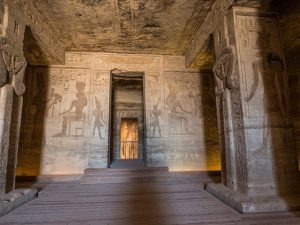
The Holy of Holies
Despite the fact that the holy of holies in any temple is the most important part of the temple, we notice that the temple of Hathor is considered very small when compared to the great temple. This indicates that the rituals were performed in the great temple, while the small temple was dedicated only to the queen and her children to offer sacrifices to the gods. On the lintel of the entrance to the holy of holies, Ramses II and his wife are depicted in front of the goddesses Hathor and Mut. The god Hapi, the god of the Nile, is depicted on the inner lintel of the door. On the outer lintel, Ramses II is depicted. On the southern wall of the holy of holies, the queen is depicted holding a censer and a sistrum in front of Hathor and Mut. On the northern wall, the king and his wife are depicted in front of the gods.
The western wall, which is the most important part of the holy of holies,
s carved with the goddess Hathor as a cow emerging from the western mountain, and the king stands below her in a small size to enjoy her protection (similar to the idea of the Avenue of the Sphinxes). On either side of this carving are two Hathoric columns, and the king is depicted on the left offering flowers to the goddess. On either side of the holy of holies are two small chambers used to store the tools used in the temple rituals and to store the offerings.
King Ramesses II worships the gods inside the Holy of Holize
Queen Nefertari in front of the goddess Hathor in the form of a cow
